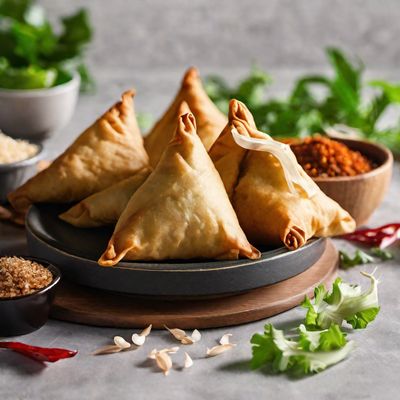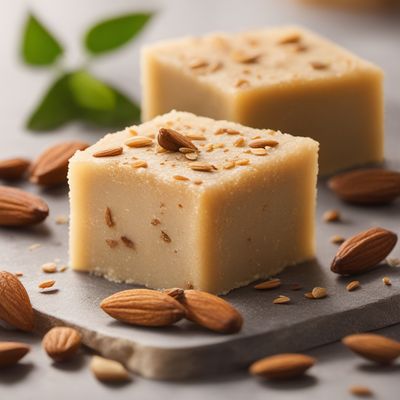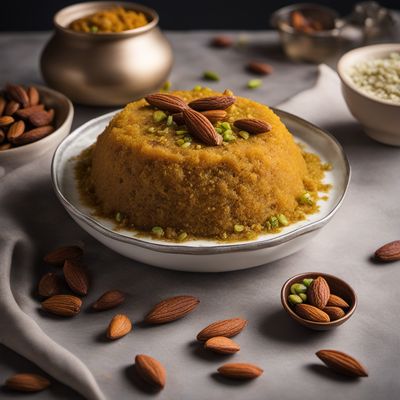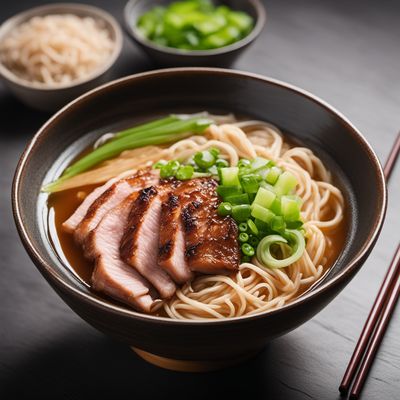
Recipe
Japanese-style Samosa
Sakura Samosa: A Fusion of Indian and Japanese Flavors
4.8 out of 5
In the context of Japanese cuisine, this recipe adapts the traditional Indian samosa into a delightful fusion dish. The crispy pastry pockets are filled with a unique blend of Japanese ingredients, creating a harmonious balance of flavors. Get ready to experience the best of both worlds with this Japanese-style samosa!
Metadata
Preparation time
30 minutes
Cooking time
20 minutes
Total time
50 minutes
Yields
4 servings
Preparation difficulty
Medium
Suitable for
Vegetarian, Vegan (if using vegan miso paste), Dairy-free, Nut-free, Egg-free
Allergens
Soy (in miso paste and soy sauce), Wheat (in all-purpose flour)
Not suitable for
Gluten-free (due to the use of all-purpose flour)
Ingredients
While the original Indian samosa features a spiced potato and pea filling, this Japanese adaptation incorporates a filling inspired by traditional Japanese flavors. The spices are replaced with umami-rich ingredients like miso, soy sauce, and ginger, giving the samosa a distinct Japanese twist. Additionally, the pastry is made lighter and crispier to suit the Japanese preference for delicate textures. We alse have the original recipe for Samosa, so you can check it out.
-
2 cups (250g) all-purpose flour 2 cups (250g) all-purpose flour
-
1/2 teaspoon salt 1/2 teaspoon salt
-
1/4 cup (60ml) vegetable oil 1/4 cup (60ml) vegetable oil
-
1/2 cup (120ml) water 1/2 cup (120ml) water
-
1 tablespoon sesame oil 1 tablespoon sesame oil
-
1 tablespoon grated ginger 1 tablespoon grated ginger
-
2 cloves garlic, minced 2 cloves garlic, minced
-
1 cup (150g) diced tofu 1 cup (150g) diced tofu
-
1 cup (150g) shredded cabbage 1 cup (150g) shredded cabbage
-
1/2 cup (75g) sliced shiitake mushrooms 1/2 cup (75g) sliced shiitake mushrooms
-
2 tablespoons miso paste 2 tablespoons miso paste
-
1 tablespoon soy sauce 1 tablespoon soy sauce
-
1 tablespoon mirin 1 tablespoon mirin
-
1 tablespoon cornstarch 1 tablespoon cornstarch
-
Vegetable oil, for frying Vegetable oil, for frying
Nutrition
- Calories (kcal / KJ): 280 kcal / 1172 KJ
- Fat (total, saturated): 12g, 2g
- Carbohydrates (total, sugars): 35g, 2g
- Protein: 8g
- Fiber: 3g
- Salt: 1.5g
Preparation
-
1.In a large bowl, combine the all-purpose flour and salt. Add the vegetable oil and mix until the mixture resembles breadcrumbs.
-
2.Gradually add water and knead the dough until it becomes smooth and elastic. Cover the dough with a damp cloth and let it rest for 30 minutes.
-
3.In a pan, heat sesame oil over medium heat. Add grated ginger and minced garlic, and sauté for a minute until fragrant.
-
4.Add diced tofu, shredded cabbage, and sliced shiitake mushrooms to the pan. Cook for 5 minutes until the vegetables are slightly softened.
-
5.In a small bowl, whisk together miso paste, soy sauce, mirin, and cornstarch. Pour the mixture into the pan and stir well to coat the vegetables. Cook for another 2 minutes until the filling thickens. Remove from heat and let it cool.
-
6.Divide the dough into small balls and roll each ball into a thin circle.
-
7.Cut each circle in half and fold each half into a cone shape, sealing the edges with water.
-
8.Fill each cone with the cooled vegetable filling and seal the top edges with water.
-
9.Heat vegetable oil in a deep pan or fryer. Fry the samosas in batches until they turn golden brown and crispy. Remove from oil and drain on a paper towel.
-
10.Serve the Japanese-style samosas hot with a dipping sauce of your choice.
Treat your ingredients with care...
- Tofu — Press the tofu to remove excess moisture before dicing it. This will help it absorb the flavors better.
- Shiitake mushrooms — Soak dried shiitake mushrooms in warm water for 20 minutes before slicing them. This will rehydrate them and enhance their texture.
Tips & Tricks
- For a healthier version, you can bake the samosas instead of frying them. Brush them with oil and bake at 200°C (400°F) for 20-25 minutes until golden brown.
- Experiment with different fillings by adding ingredients like cooked edamame, bamboo shoots, or pickled vegetables to the filling mixture.
- Serve the samosas with a side of Japanese pickles or a refreshing cucumber salad for a complete meal.
Serving advice
Serve the Japanese-style samosas as an appetizer or a snack. They are best enjoyed when hot and crispy. Accompany them with a dipping sauce made from soy sauce, rice vinegar, and a touch of chili oil for an extra kick.
Presentation advice
Arrange the samosas on a platter, garnished with a sprinkle of sesame seeds and finely chopped green onions. The golden brown color of the samosas will contrast beautifully with the vibrant green garnish.
More recipes...
More Indian cuisine dishes » Browse all

Malpua
Malpua is a sweet Indian pancake made with flour, milk, and sugar. It is a popular dessert in India and is often served during festivals and celebrations.

Khaja
Khaja is a popular Indian sweet that is made from flour, sugar, and ghee. It is typically served during festivals and special occasions, and is...

Balep
Balep is a traditional bread from the Indian state of Karnataka. It is a flatbread that is typically made with rice flour and is often served with...
More Japanese cuisine dishes » Browse all
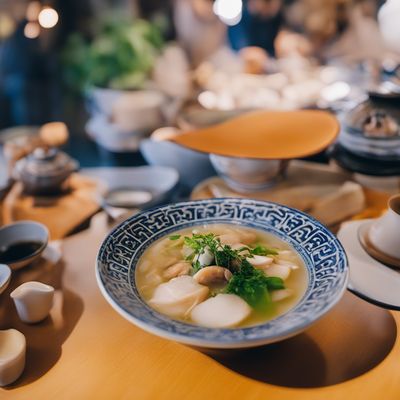
Ichigoni
Ichigoni is a traditional Japanese soup that is typically made with clams and miso. This dish is known for its umami flavor and is often served as...
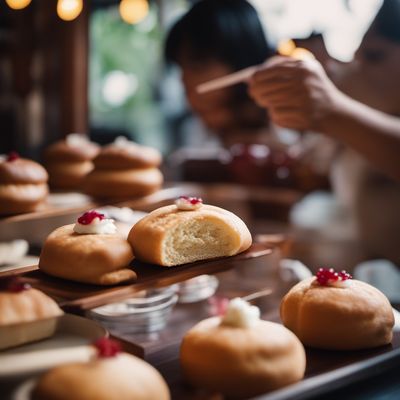
Tsukisamu anpan
Tsukisamu anpan is a traditional Japanese sweet bread filled with sweet red bean paste. It is a popular snack in Japan and is often enjoyed with...

Kohada nigiri sushi
Gizzard Shad Nigiri
Kohada nigiri sushi is a type of sushi that is made with gizzard shad. It is a popular dish in Japan and is often served in sushi restaurants.

